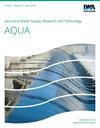Spatial distribution, formation mechanism, and health risk assessment of high-fluoride groundwater at the largest antimony mine in Hunan Province, China
IF 4.3
Q2 Environmental Science
引用次数: 0
Abstract
To date, few systematic studies have been conducted of the spatial distribution, formation mechanism, and health risks of high-fluoride (F−) shallow groundwater in humid and semi-humid areas of the Xikuangshan antimony mine, Hunan Province, China. In this study, during March and April 2022, a total of 39 shallow groundwater samples were collected and analyzed using factor analysis, principal component analysis, and health risk assessment. F− concentrations in the shallow groundwater were found in the range of 0.08–15.00 mg/L (mean: 1.21 mg/L), with 25.64% of the samples having F− concentrations higher than in the Chinese national standard for drinking water (1.00 mg/L). Principal component analysis revealed that the main source of F− in the shallow groundwater samples is cation exchange, accounting for 73.40%, followed by the dissolution and precipitation of F-bearing minerals (15.10%) and human influence (11.50%). Among different age groups, children had the highest percentage of individuals (36.38%) with an F− intake above the health risk quotient safety limit, followed by adult males (23.12%), teenagers (22.21%), and infants (21.22%). The findings of this study will contribute to devising strategies for the provision of safe drinking water and the management of the geological environment.湖南省最大锑矿高氟地下水空间分布、形成机制及健康风险评价
迄今为止,对湖南省锡矿山锑矿湿润半湿润区高氟浅层地下水的空间分布、形成机制及健康风险的系统研究较少。本研究于2022年3月至4月采集了39份浅层地下水样本,采用因子分析、主成分分析和健康风险评价等方法进行分析。浅层地下水中F -浓度在0.08 ~ 15.00 mg/L之间,平均值为1.21 mg/L,其中25.64%的样品F -浓度高于中国饮用水国家标准(1.00 mg/L)。主成分分析表明,浅层地下水样品中F−的主要来源是阳离子交换,占73.40%,其次是含F矿物的溶解和沉淀(15.10%),人为影响(11.50%)。在不同年龄组中,儿童的氟摄入量超过健康风险商安全限值的比例最高(36.38%),其次是成年男性(23.12%)、青少年(22.21%)和婴儿(21.22%)。这项研究的结果将有助于制定提供安全饮用水和管理地质环境的战略。
本文章由计算机程序翻译,如有差异,请以英文原文为准。
求助全文
约1分钟内获得全文
求助全文
来源期刊
CiteScore
4.70
自引率
0.00%
发文量
74
审稿时长
4.5 months
期刊介绍:
Journal of Water Supply: Research and Technology - Aqua publishes peer-reviewed scientific & technical, review, and practical/ operational papers dealing with research and development in water supply technology and management, including economics, training and public relations on a national and international level.

 求助内容:
求助内容: 应助结果提醒方式:
应助结果提醒方式:


